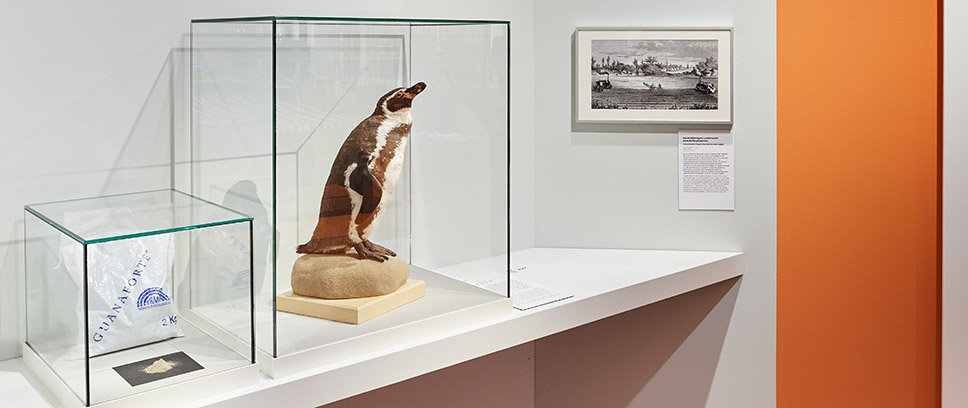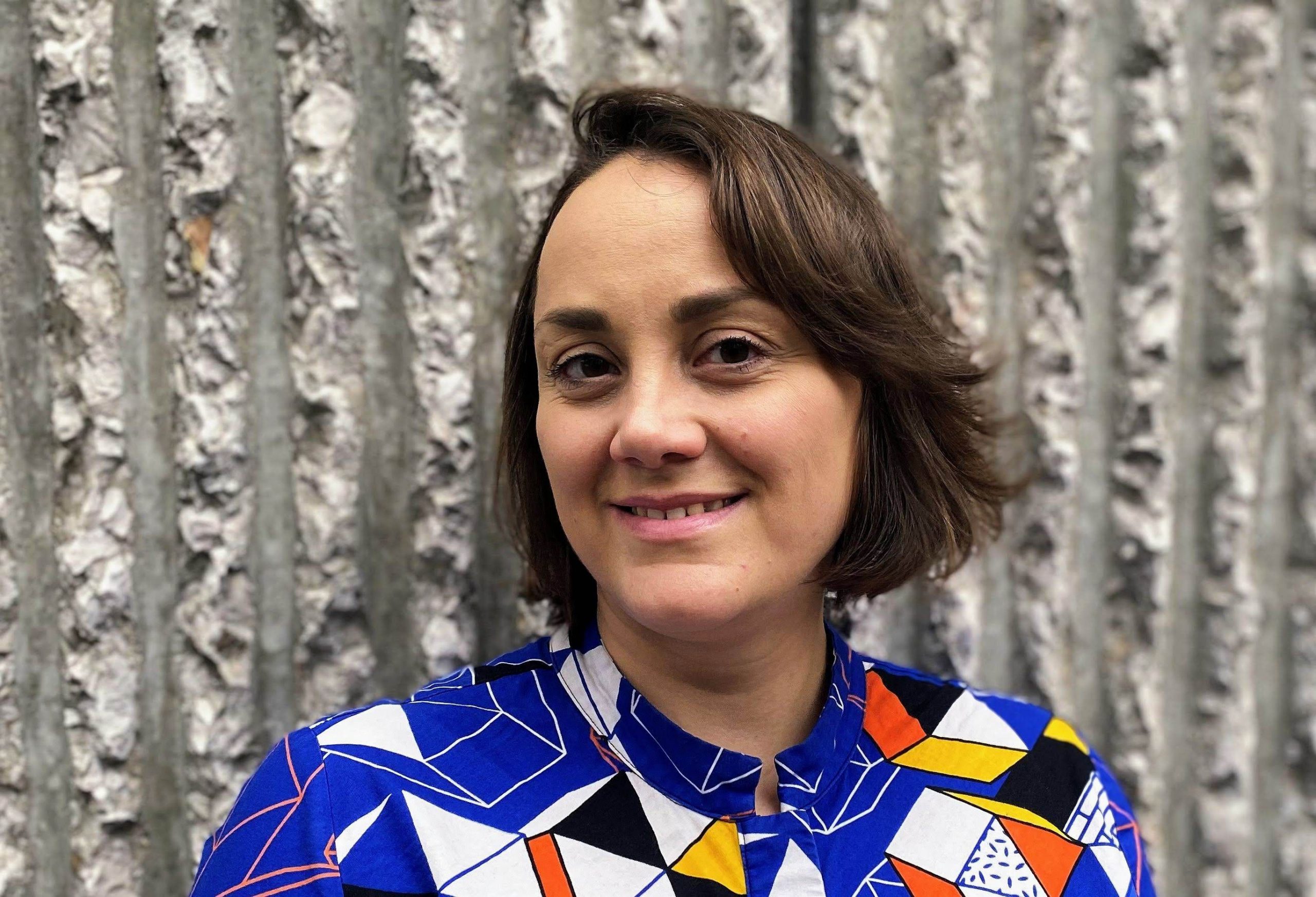
What’s that for? A Humboldt penguin and a packet of guano dung
Kati Renner | 19 July 2022
What does a preserved specimen of a so-called Humboldt penguin and a packet of guano dung have to do with Karl Marx and capitalism? Project assistant Kati Renner reports on two surprising objects in the exhibition “Karl Marx and Capitalism”.
In the exhibition, visitors encounter a 50 cm high stuffed Humboldt penguin and a packet of guano at the so-called theme island “Nature and Ecology”. Typical of this kind of penguin, it has a distinctive, black, horseshoe-shaped stripe across its breast. As with the beak and feet, the feathering on the bird’s back is blackish-grey, whereby the underside is largely white. The term guano refers to the dung of South American seabirds, one of which is this variety of penguin. It has borne the name of its European discoverer, Alexander von Humboldt, since the 19th century. For centuries, guano has been successfully used as fertilizer in agricultural production along the South American Pacific coast. Alexander von Humboldt first brought a sample of guano from Peru to Europe in 1802. Chemists such as Justus von Liebig verified its superior quality as fertilizer, thus triggering a large-scale boom of exploitation and export by Europeans. Guano was used to counter the increasing depletion of the soil in Europe and thus to solve the food issues caused by the constantly growing population. An immediate result of the extraction of the dung was to destroy the natural habitat of the seabirds, so that the guano resources were soon depleted. The over-exploitation in South America caused a massive disturbance of the ecosystem, the violent suppression of the colonised peoples, as well as the economic exploitation of the workers. These included above all unskilled Chinese and South East Asian wage-workers, known as coolies, who had been shipped to South America and forced to work in slave-like conditions, despite the abolition of slavery in South America. The scarcity of the natural resource also led to violent annexations and conflicts, of which the 1856 “Guano Islands Act” of the US Congress and the Spanish–South American War (the so-called “Guano War”) of 1864–66 are representative.
Karl Marx and Guano
Karl Marx occupied himself throughout his life with a great variety of subjects. In a dispute with the British national economist Thomas Robert Malthus, Marx attempted to debunk Malthus’s claim that the global feeding problems could not be solved. Marx at first saw a supposedly easy solution through the use of guano. He had become acquainted with this natural fertilizer and its effects by reading various editions of Liebig’s Agricultural Chemistry. He was convinced that progress in science and technology would solve the problem of the diminishing soil fertility and thus realise the potential for greater social freedom. Marx did not publish these thoughts, but in his notebooks on agriculture he wrote how he planned to describe the “metabolism” between man and nature in Das Kapital. On the ability to increase the agricultural yield he noted: “In a soil that consists entirely of sand and clay, it is enough to mix in a small quantity of guano to get the richest harvests of maize.”[1]
But since the scientists observed a continuing depletion of the soil despite the intensive application of the fertilizer, Marx recognised the natural limits of this form of capitalism and revised his assessment. In spite of the scientific and technical progress, he reasoned, guano only delayed the problem of the deficiency of nutrients and the threatened exhaustion of the soil. On this destructive process and the added exploitation of the workers as a result of the capitalistic means of production, Marx wrote in Das Kapital: “All progress in capitalist agriculture is a progress in the art, not only of robbing the worker, but of robbing the soil; all progress in increasing the fertility of the soil for a given time is progress towards ruining the more long-lasting sources of that fertility. […] Capitalist production, therefore, develops technology […] only by sapping the original sources of all wealth: the soil and the labourer.”[2] Moreover, in 1857, Marx criticised in the New York Daily Tribune that the Chinese coolies who were forced to extract the guano on the coasts of Peru were “sold into the worst conditions of slavery” by British agents.[3] The Humboldt penguin and its guano are therefore a symbol of global capitalism and ecological imperialism in the 19th century, which exploited both the natural resources and the workers in non-European countries.
Was Marx an eco-activist?
In the research on Marx there are differing opinions about his ecological consciousness and different conclusions about whether there is a systematic approach to this topic in his works.[4] For Marx the division between man and nature represented above all a problem of the capitalist means of production, which was to be overcome in communism through the abolition of private property. The planned third volume of Das Kapital, published posthumously by his collaborator Friedrich Engels, contains this astoundingly farsighted perception with respect to sustainability in light of limited resources: “From the standpoint of a higher economic form of society, private ownership of the globe by single individuals will appear quite as absurd as private ownership of one man by another. Even a whole society, a nation, or even all simultaneously existing societies taken together, are not the owners of the globe. They are only its possessors, its usufructuaries, and, like boni patres familias, they must hand it down to succeeding generations in an improved condition.”[5]
References:
[1] MEGA2 IV/9, p. 187.
[2] Karl Marx: Das Kapital. Kritik der Politischen Ökonomie. In: MEW, vol. 23, p. 529f.
[3] Karl Marx: Whose Atrocities? In: New York Daily Tribune, 10 April 1857.
[4] Cf. Bruno Kern‘s article in the exhibition catalogue.
[5] Karl Marx: Capital. Volume Three, p. 567 (https://www.marxists.org/archive/marx/works/download/pdf/Capital-Volume-III.pdf) German in: MEW, vol. 25, p. 784.
|
Foto: Privat |
Kati RennerKati Renner is an art historian. She acquired her doctorate at the Technical University Dresden with a monographic dissertation on the artist Otto Hettner (1875–1931). From 2018 to 2020 she completed a traineeship at the Berlinerische Galerie and worked there on the exhibitions “Lotte Laserstein”, “Underground Architecture” and “Gezeichnete Stadt”. Articles by her have appeared, e.g., in the exhibition catalogues “Neue Sachlichkeit in Dresden” (2011) and “Gezeichnete Stadt” (2020). From August 2020 she worked as a project assistant in the exhibition “Karl Marx and Capitalism”. |
